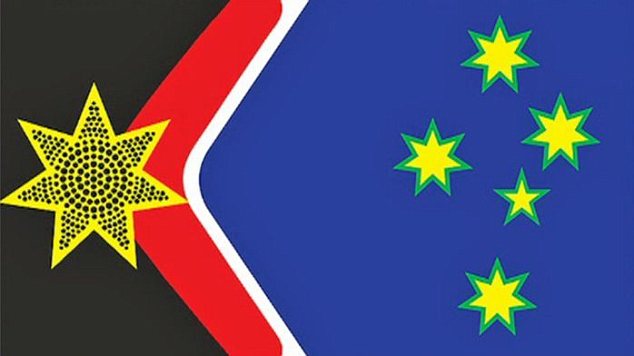Will This Be Australia’s New Flag? Calls to Drop Union Jack as Country Bids to ‘Move On’ from British Heritage
Matt Blake, Daily Mail (London), January 28, 2013
A new flag has been designed in Australia in a bid to ‘move on’ from the country’s colonial past.
Military historian Dr John Blaxland, of the Australian National University, came up with the idea because he says the current one does not embrace all aspects of Australian culture.
Rather than just a straightforward nod to the country’s British heritage, he says he wanted a flag that acknowledge Australia’s Aboriginal communities as well as its growing multiculturalism.
‘People can identify with various parts of it and see that Australia is actually a multicultural place with a rich history that reaches back for generations,’ he told the Daily Telegraph.
His flag contains 250 dots to the left to represent the many Aboriginal dialects as well as the immigrant languages spoken on the streets of Sydney, Perth, Melbourne and other towns and cities across the nation.
There is also a red section in the shape of a boomerang, and a traditional representation in green and yellow of the Southern Cross constellation, made up of five stars – one small five-pointed star and four, larger, seven-pointed stars.
But he says he did not want to completely disregard modern Australia’s British roots and added a white stripe to ‘echo’ that on the Union Flag.
‘We can move on, we can reflect on our history but also acknowledge in the design… that we can’t completely trash the British heritage,’ he added.
‘I get the significance of the current flag, I get the significance of the Union Jack. I also get that a lot of people don’t like it. I think we need to find a compromise, something that is going to be inclusive and appeals to all Australians.’
Australian author and former rugby union player Peter FitzSimons backed calls for a new flag, saying the current one ‘is no longer a symbol that unites us (but) it divides us’.
‘Why on earth, in the 21st century, do we still have a flag that reserves 25 per cent of its acreage proclaiming our allegiance, first and foremost, to Great Britain!?’ he wrote in The Sydney Morning Herald.
‘You can’t believe in multiculturalism and support a flag that asserts the primacy of the Anglo race. We need a flag that reflects the equality of our citizens, not vaunts one lot over other.’
The new flag offering comes two days after a group of Aboriginal protesters set fire to the Australian flag outside the country’s Parliament in Canberra as the rest of the nation celebrated Australia Day.
A video captured showed protesters outside Parliament setting light to the flag and spitting on it while chanting, ‘Always was, always will be Aboriginal land.’
A day before that, riot police were called to form a human shield around Prime Minister Julia Gillard and escort her out of a Canberra restaurant after hundreds of angry protesters surrounded the building.
Australia’s national flag has remained a controversial issue ever since its invention in 1901.
Australia’s 460,000 Aborigines make up two per cent of the 21 million population, most living in remote communities or towns.
But for around 50,000 years, prior to the arrival of British Settlers in 1788, the country was occupied exclusively by Aboriginal and Torres Strait Islander peoples.
Both tribes have their own flags.
The aboriginal flag is red and black with a yellow sun at its centre while the Torres Strait Islander’s flag is green, blue and black with a white star at its centre surrounded by a white dhari (dancer’s headdress).
Both were finally recognised by the Australian government in 1995 when it granted them Flag of Australia status, under the Flags Act 1953.
On Friday, Deputy Prime Minister Wayne Swan reignited the debate around whether Australia should become a republic, saying the 80-year-old Bodyline cricket scandal had shown that the British could be ‘ruthless’ and self serving.
He said the English cricket team’s ‘life-threatening’ bowling tactics during the 1932 Bodyline series ‘woke Australians up’ to renounce Britain’s self-serving ‘gentlemanly values’.
‘What the Bodyline series showed.’ he wrote in a newspaper piece to coincide with Australia Day, ‘was that while we refuse to put on airs and graces, Aussies are not a ruthless, ‘whatever it takes’ people,’ he wrote.
The push for Australia to become a republic has fallen out of the spotlight since the loss of a referendum on the issue in 1999. However some polls show a possible resurgence in the idea.
A 2010 Morgan Poll that asked: ‘Do you think Australia should have a new design for our National Flag?’ was supported by 29 per cent of respondents and opposed by 66 percent, with 5 per cent uncommitted.
















